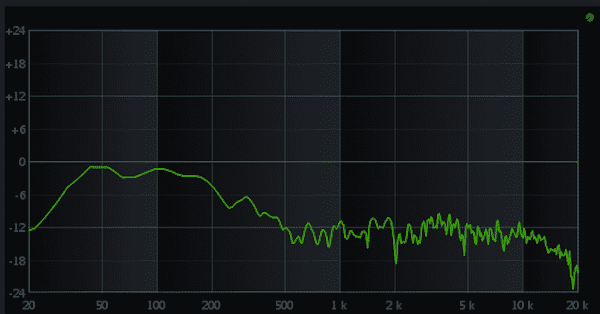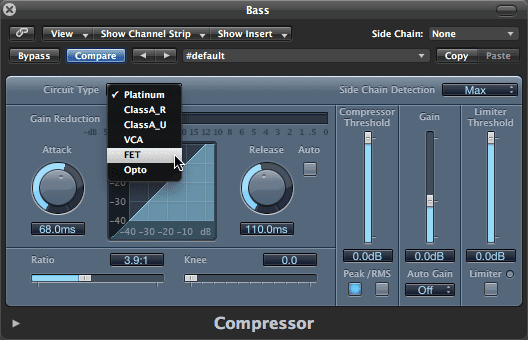3. Compression
Compression is often thought of as a process designed to make things louder or smooth out dynamics, but in many cases it should be viewed mainly as a tonal shaping tool for adding punch and definition. Bass is no exception, especially given that bass elements already hog a significant portion of the available headroom and synth basslines typically have little dynamic range.
Let’s see how compression can be used to shape this bassline:
Audio PlayerStart with a medium to fast attack, moderate release time, a ratio of 2:1 or 4:1 and slowly bring the threshold down until you get 4-6 dB of gain reduction. We’re using Logic’s built-in compressor plugin set to the default Platinum mode:
Here’s how it sounds:
Audio PlayerThe denser the bass notes, the faster the release will need to be. The release control should be set to a time which allows the compressor to recover between notes.
Changing the attack time is a way to emphasise the initial onset of each note. Adjust the attack for maximum punch. Too slow and you’ll lose any benefit. For an example of how the attack time affects the sound, the following clip demonstrates the effect of gradually increasing the attack time while leaving all other settings in the same place.
Audio PlayerDon’t forget that different types of compression with the same apparent settings can sound very different. Logic offers six different modes in the basic compressor plugin:
Here’s how they sound with all other settings equal:
Audio Player Audio Player Audio Player Audio PlayerFinally, avoid very fast attack and release times. These can lead to audible distortion on low frequency material, which is most noticeable on sub-bass parts.



08.15 PM
Nice article guys! I’m lovin Attack Magazine, in my opinion it’s the best website about electronic music 😉 thanks a lot! Cheers from Brazil
08.30 AM
I am really really enjoying the work you are doing with your articles!
Keep up the good work.
05.11 PM
I love these articles! I noticed that this lesson said it would teach us to make better basslines, but even though in the first page it saya that melody is one of the main things that needs to be considered; but there arent any specific tips in this article about choosing bassline notes! 🙂
I love you guys, can ya break that part down some more? Or do you just do the melody by ear?
07.04 PM
^ BIlly, I don’t want to be annoying but this article is one of the most complete I’ve ever seen on the internet. It’s kinda ungrateful to ask EVEN more about it… seriously :/
07.53 PM
@Billy, @Claudio…
No problems at all with the request…
It’s true that, of course, the melody plays a (the?) fundamental part in a successful bassline. This piece wasn’t about programming – but I certainly suggest reading the various Passing Notes pieces (http://www.attackmagazine.com/technique/passing-notes/) which are designed to give a good grounding in music theory, including the disco basslines piece (http://www.attackmagazine.com/technique/passing-notes/passing-notes-disco-house-basslines/) which has a lot of insights – even if you hate disco!
And, as ever, keep watching this space!
Dave@Attack
06.21 AM
Really helpful stuff, muchas gracias amigos!
10.02 PM
holycow. its difficult
on one dark-hand side i hope this page stays my my my own sweet little secret…. anyhow thanks for ur great work!!!
01.23 PM
This is a great article, thanks! However, the bass player plugin shows that there is no substitute for a real practiced human! Or a sample of one: but then of course you have to spend three months slicing and dicing ala Justice to keep the lawyers off your tail!
10.28 AM
hi, I own the tal u no lx but i cant find the mrs digit preset, does it come with it or is named something else?
Thanks!
11.11 AM
Luke – well spotted. We’re pretty sure the Mrs Digit patch is a Mr Fingers-inspired bass sound the writer created for the audio example. U-NO-LX is so simple that you should be able to copy the patch from the screengrab (although we had to increase the filter cutoff slightly to get the same sound).
If you’re looking for an even more accurate version of the classic Larry Heard sound, try the sub-oscillator on its own. Or you could use the pulse oscillator and set the pulse width manually to get a variety of slightly fuller or hollower sounds.
U-NO-LX is excellent for those 80s analogue bass sounds. We’re big fans.
http://www.attackmagazine.com/reviews/gear-software/tal-u-no-lx/
12.58 AM
Attack WE LOVE YOU.
03.37 PM
Thanks so much for this. Learning so much through your tutorials.
04.52 PM
very hot magazine! keep it coming
01.08 AM
this tutorial came in very handy for me, thank you attack people..very well written and it reminded me of some stuff i (probably) already had forgotten to consider again. big ups from vienna
02.28 AM
attack magazine thank you very much. very useful article .
08.28 PM
Awesome article. Thanks
12.47 AM
Another incredible article. Informative and clearly explained.
Attack is rapidly becoming my number one resource for production tips.
03.53 PM
Just got wind of this site. I will definitely be here more than ever. Really enlightening
08.22 PM
Just found this magazine, excellent well written articles. This one was excellent and covered lots of stuff. Ill be trying that notch on my bass eq real soon. Keep it up guys, great stuff
03.41 AM
If you’re using reverb on your bass, put the EQ before the reverb. It won’t matter so much for bass as for other instruments, but it will sound somewhat unnatural to have the reverb filtered.
01.36 PM
How have I missed this article? Great read as ever guys and very informative!
08.02 PM
great article but please for the love of god fix or change the sound player, its freezes after 2 seconds and never starts playing again, i have to refresh couple of times to even hear the whole soundclip
09.55 AM
I am new to this site and I must say the few articles I’ve read are quite good.
keep up the good work
12.55 AM
The best articles I’ve read in my life. Great work guys. Keep it up!
10.54 AM
Awesome tips—could u possibly provide the readers with a PDF version of the articles?
11.00 AM
amazing stuff guys……..really great content!
06.32 PM
Does this work on 808 bass?
12.16 AM
THIS IS SHIT
10.42 PM
Thanks for all of your excellent tutorials
06.04 PM
Nice article. I have just released a free youtube series on how to write bass lines too. Check it out!
https://www.youtube.com/watch?v=NHIHncaNaDw
02.55 PM
Any other software alternatives for the VOG plug-in you mentioned for boosting low-end?
Boz ‘Bark Of Dog’ resonant filter?
Tone2 Bifilter?
Any EQ like the Logic EQ or Pro-Q with a resonant low-shelf?
02.55 PM
oh, and great article btw. Attack Mag is fast becoming my favourite site for these tips and walkthroughs!
05.27 PM
Thanks! Best tutorial